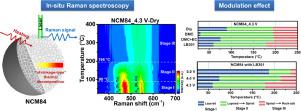Energy Storage Materials ( IF 18.9 ) Pub Date : 2022-01-10 , DOI: 10.1016/j.ensm.2022.01.007 Jiyang Li 1 , Haiming Hua 1 , Xiangbang Kong 1 , Huiya Yang 1 , Pengpeng Dai 1 , Jing Zeng 1 , Jinbao Zhao 1

|
The thermal stability of cathode materials is very important to the safety of lithium-ion batteries (LIBs), especially the promising high-nickel LiNixCoyMn1-x-yO2 (NCM, 0.6 ≤ x < 1) materials. Generally, the thermal decomposition is believed to begin at the electrode/electrolyte interface. However, due to the lack of suitable diagnostic tools, current recognition of their near-surface structural thermal stability still remains limited. Raman spectroscopy can not only sensitively reflect changes in the local metal-oxygen coordination structure, but also conveniently detect the near-surface structural information with the suitable spatial resolution and penetration depth. Here, through developing the in-situ heating Raman spectroscopy method, the thermal decomposition process of the near-surface structure of the fully charged high-nickel NCM material is confirmed, which is much lower than existing recognition. Interestingly, the thermal decomposition of the secondary particle bulk is evidenced to be obviously lagging behind the particle surface, exhibiting a centripetally diffused thermal decomposition within the secondary particle. In addition, the near-surface structural thermal stability is revealed to be significantly modulated by the electrolyte components by means of the dehydrogenation, adsorption, oxidation of carbonate solvents and the decomposition of lithium salt. Meanwhile, it weakens with the increased surface oxidation state of high-nickel NCM materials. Consequently, this work can remind us to rethink the true thermal stability of high-nickel NCM materials and guide targeted improvement of their interfacial thermal stability.
中文翻译:

原位探测高镍层状正极材料的近表面结构热稳定性
正极材料的热稳定性对锂离子电池(LIBs)的安全性非常重要,尤其是前景广阔的高镍LiNi x Co y Mn 1-xy O 2 (NCM, 0.6 ≤ x< 1) 材料。一般认为,热分解开始于电极/电解质界面。然而,由于缺乏合适的诊断工具,目前对其近地表结构热稳定性的认识仍然有限。拉曼光谱不仅可以灵敏地反映局部金属-氧配位结构的变化,而且可以方便地检测出具有合适空间分辨率和穿透深度的近地表结构信息。在此,通过开发原位加热拉曼光谱方法,证实了完全充电的高镍NCM材料近表面结构的热分解过程,远低于现有认识。有趣的是,二次粒子本体的热分解明显滞后于粒子表面,在二次粒子内表现出向心扩散的热分解。此外,通过碳酸盐溶剂的脱氢、吸附、氧化和锂盐的分解,电解质组分显着调节了近表面结构的热稳定性。同时,它随着高镍NCM材料表面氧化态的增加而减弱。因此,这项工作可以提醒我们重新思考高镍NCM材料的真正热稳定性,并指导有针对性地提高其界面热稳定性。通过碳酸盐溶剂的脱氢、吸附、氧化和锂盐的分解,电解质组分显着调节了近表面结构的热稳定性。同时,它随着高镍NCM材料表面氧化态的增加而减弱。因此,这项工作可以提醒我们重新思考高镍NCM材料的真正热稳定性,并指导有针对性地提高其界面热稳定性。通过碳酸盐溶剂的脱氢、吸附、氧化和锂盐的分解,电解质组分显着调节了近表面结构的热稳定性。同时,它随着高镍NCM材料表面氧化态的增加而减弱。因此,这项工作可以提醒我们重新思考高镍NCM材料的真正热稳定性,并指导有针对性地提高其界面热稳定性。











































 京公网安备 11010802027423号
京公网安备 11010802027423号